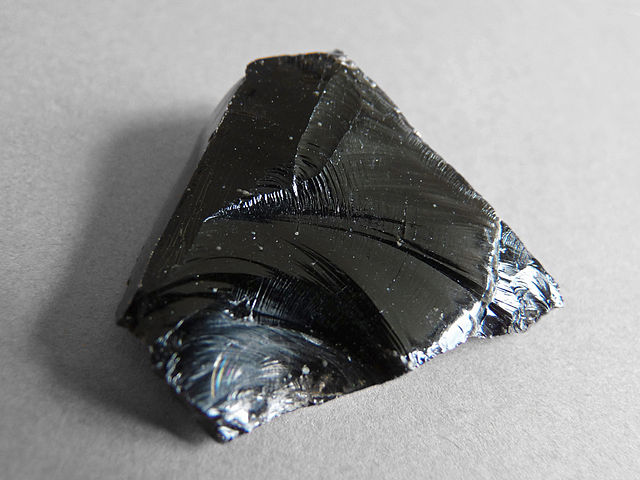Obsidian
Obsidian is a naturally occurring volcanic glass formed when lava extruded from a volcano cools rapidly with minimal crystal growth. It is an igneous rock.
Obsidian is mineral-like, but not a true mineral because, as a glass, it is not crystalline; in addition, its composition is too variable to be classified as a mineral. It is sometimes classified as a mineraloid.
Occurrence
Obsidian is found near volcanoes in locations which have undergone rhyolitic eruptions. It can be found in Argentina, Armenia, Azerbaijan, Australia, Canada, Chile, Georgia, Ecuador, El Salvador, Greece, Guatemala, Hungary, Iceland, Italy, Japan, Kenya, Mexico, New Zealand, Papua New Guinea, Peru, Scotland, The Canary Islands, Turkey and the United States.
Obsidian flows which may be hiked on are found within the calderas of Newberry Volcano and Medicine Lake Volcano in the Cascade Range of western North America, and at Inyo Craters east of the Sierra Nevada in California. Yellowstone National Park has a mountainside containing obsidian located between Mammoth Hot Springs and the Norris Geyser Basin, and deposits can be found in many other western U.S. states including Arizona, Colorado, New Mexico, Texas, Utah, and Washington, Oregon and Idaho. Obsidian can also be found in the eastern U.S. states of Virginia, Pennsylvania and North Carolina.
Prehistoric use
The first known archaeological evidence of usage was in Kariandusi (Kenya) and other sites of the Acheulian age (beginning 1.5 million years BP) dated 700,000 BC, although only very few objects have been found at these sites relative to the Neolithic. Manufacture of obsidian bladelets at Lipari had reached a high level of sophistication by the late Neolithic, and was traded as far as Sicily, the southern Po river valley, and Croatia.
Obsidian bladelets were used in ritual circumcisions and cutting of umbilical cords of newborns.
Obsidian was valued in Stone Age cultures because, like flint, it could be fractured to produce sharp blades or arrowheads in a process called knapping. Like all glass and some other naturally occurring rocks, obsidian breaks with a characteristic conchoidal fracture. It was also polished to create early mirrors.
Use by Pre-Columbian cultures
Pre-Columbian Mesoamericans' use of obsidian was extensive and sophisticated; including carved and worked obsidian for tools and decorative objects. Mesoamericans also made a type of sword with obsidian blades mounted in a wooden body. Called a macuahuitl, the weapon could inflict terrible injuries, combining the sharp cutting edge of an obsidian blade with the ragged cut of a serrated weapon. The pole arm version of this weapon was called tepoztopilli.
Obsidian mirrors were used by some Aztec priests for scrying, to conjure visions and give divinations. They were connected with Tezcatlipoca, god of obsidian and sorcery, whose name can be translated from the Nahuatl language as 'Smoking Mirror’.
John Dee used a scrying mirror made of polished obsidian for divination of the future.
